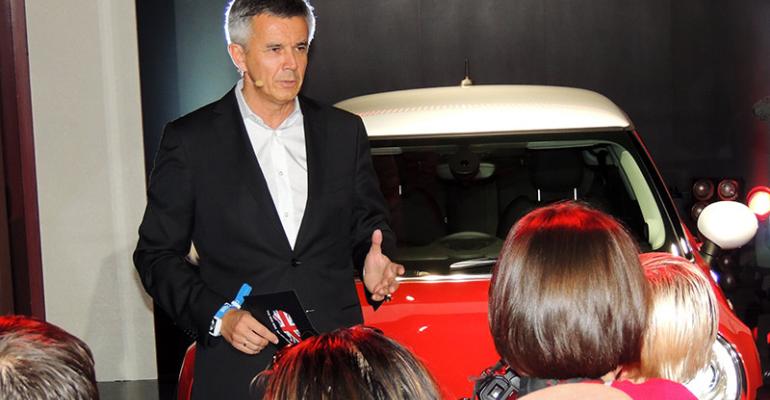LOS ANGELES – The third-generation Mini Hardtop 4-seater, unveiled here Tuesday night and a day earlier at the assembly plant in Oxford, U.K., may look an awful lot like the current model when it starts showing up on U.S. streets next spring.
The Mini Cooper designers insisted on retaining certain characteristics – the soft edges, circular headlamps, short overhangs, tall roofline and go-cart handling – and Peter Schwarzenbauer, BMW Group's board member for Mini, is glad they did. He says iconic designs must be modernized but generally preserved.
“With an iconic design, you never should put a revolutionary approach to it,” he tells WardsAuto after the unveiling on the eve of press days here at the Los Angeles auto show.
“It would have been a mistake in my eyes,” he says, to launch a clean-sheet redesign that would have abandoned much of Mini’s styling legacy established over decades.
“Most people would say, ‘I don’t know if this is still a Mini,’” Schwarzenbauer says. “The only task you have with iconic designs is, how do you keep it modern? I think our designers did a wonderful job. You know it’s a Mini.”
Despite the familial resemblance, Mini executives say virtually every aspect of the new vehicle, including the sheet metal, seats, grille, suspension, interior electronics and even the antenna are new.
Two gasoline direct-injection engines for the U.S. are completely new, the “B38” 3-cyl. in the Cooper and “B48” 4-cyl. in the Cooper S, both of them turbocharged. For the first time in Mini’s modern era, a naturally aspirated engine will not be available in the U.S.
“New technology in these engines allows you to reduce fuel consumption up to 27% compared with the current generation,” Schwarzenbauer says. “At the same time, we increase performance by 10%.”
Incidentally, Mini was attempting to ship two vehicles to Detroit equipped with the new engines so WardsAuto could evaluate them as part of the 2014 Ward’s 10 Best Engines competition.
But the automaker withdrew the entries this week after deciding the pre-production vehicles were not quite up to snuff. Both engines will be evaluated next fall as part of the 2015 competition.
Mini sales have been robust since the brand came to the U.S. in 2002. Schwarzenbauer says the automaker’s 119 dealers in 38 states are excited about the new Cooper and Cooper S.
“I think most people probably in the U.S., and I must admit, including myself, could not foresee that Mini could have such a success in this country,” he says. “The small car had no heritage in the U.S., and all of a sudden we are selling this year more than 65,000 units. We are seeing a bright future for Mini in this country.”
Having driven the new car extensively, Schwarzenbauer says it reminds him even more than the previous-generation car of his favorite hobby: go-carting.





